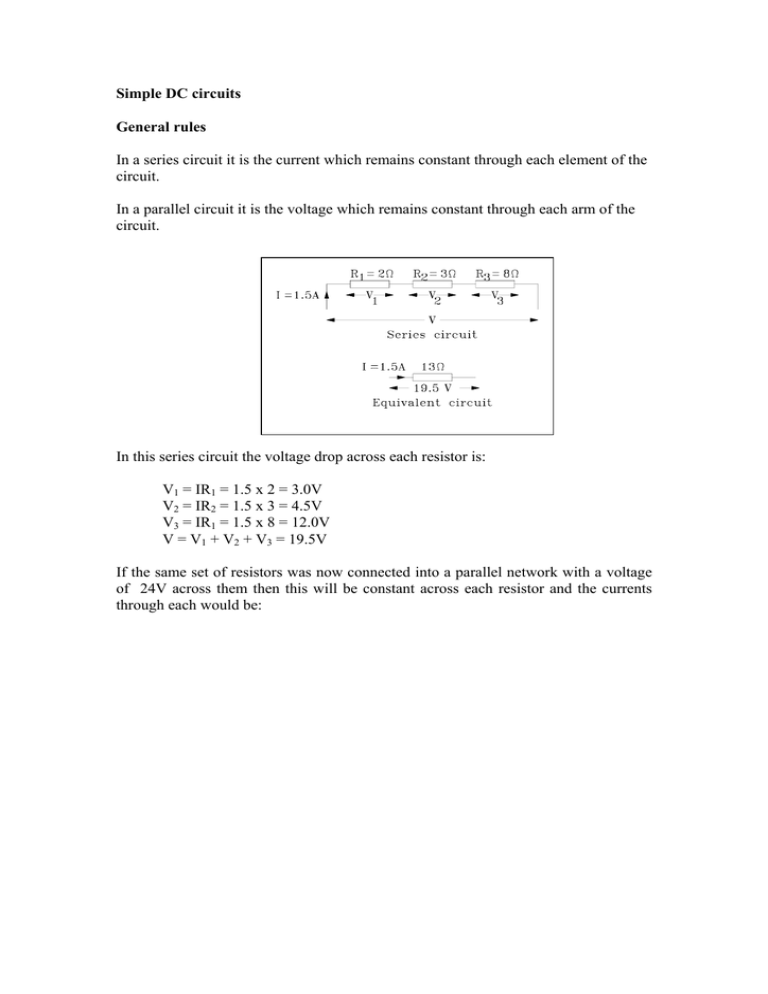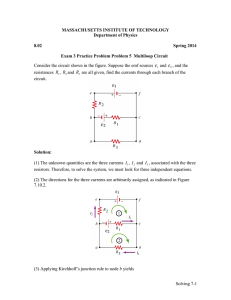Simple DC circuits General rules In a series circuit it is the current
advertisement

Simple DC circuits General rules In a series circuit it is the current which remains constant through each element of the circuit. In a parallel circuit it is the voltage which remains constant through each arm of the circuit. In this series circuit the voltage drop across each resistor is: V1 = IR1 = 1.5 x 2 = 3.0V V2 = IR2 = 1.5 x 3 = 4.5V V3 = IR1 = 1.5 x 8 = 12.0V V = V1 + V2 + V3 = 19.5V If the same set of resistors was now connected into a parallel network with a voltage of 24V across them then this will be constant across each resistor and the currents through each would be: I1 = V/R1 = 24/2 = 12 A I2 = V/R2 = 24/3 = 8 A I3 = V/R3 = 24/8 = 3 A So the total current I = I1 + I2 + I3 = 12 + 8 +3 = 23A Divider circuits A circuit which is particularly useful involves the division of a voltage between two resistors connected in series. If we have a voltage V applied across two seris resistors R1 and R2 then the total resistance is: R = R1 + R2 and the current is : I = V/(R1 + R2) Now the voltage drop across R1 is given by: V1 = I R1 = V/(R1 + R2) x R1 and the ratio of the voltage across the resistor to the total voltage is: V1/V = R1/(R1 + R2) EXAMPLE: A voltage divide is to give an output voltage of 10V from an input of 30V. Calculate the ratio of the values of resistors which must be used to produce this otput voltage. Vo/V = R1/(R1 + R2) 10/30 = R1/(R1 + R2) 10R1+ 10R2 = 30R1 10R2 = 20R1 1/2 = R1/R2 Therefore R2 must be half the value of R1 Kirchoff’s Laws Definitions • Loops: • Nodes: • Branch: All circuits can be divided into a number of closed loops A node is any point where 3 or more conductors come together# A path between two nodes which does not contain any other node. 1st law - The node rule The total current flowing towards a node is equal to the total current flowing away from the node i.e. the algebraic sum of the currents flowing towards a node is zero. The current is said to be positive if it flows into a node and negative if it flows away from a node. 2nd Law - The loop rule The algabraic sum of the emf’s in any closed loop is equal to the algabraic sum of the potential drops. This rule is states that the algabraic sum of the potential differences across all the circuit elements in a loop is zero. If we use Kirchoff’s law to analyse the current through the circuit, then the first step is to assign a sense to the current in each of the branches of the circuit - this can be done completely arbitrarily as if you get it wrong then the value of the current will be negative. In this circuit the chosen direction of the 3 currents I1, I2 and I3 is upwards. There are 2 nodes at b and d and so if we apply the node rule we obtain: I1 + I2 + I3 = 0 -I1 - I2 - I3 = 0 for node b for node d It can be seen that the second equation can be obtained from the first by multiplying by -1. This illustrates a general rule: the number of independent equations obtained by applying the node rule is one less than the number of nodes in the circuit. Next, apply the loop rule. To do this we must adopt a sign convention, there are several but we will adopt the following: a) As we pass through a source of emf from the negative to the positive then the potential change is positive. b) If we pass through a resistor in the same direction as the current then the potential change is negative. Analysing loop 1 in our circuit we get: -I1R1 + V1 - V2 + I2R2 = 0 Similarly for loop 2 we get: -I2R2 + V2 + I3R3 = 0 We could apply the loop rule to loop 3 but this would not yield any new information. This gives us another general rule: the number of independent equations obtained by applying the loop rule is one less than the total number of loops in the circuit. After analysing the circuit using both the node and the loop rules we obtain a set of simultaneous equations (3 in this case) which can be solved to find the unknown quantities. EXAMPLE: Calculate the values of the three unknown currents in the circuit below. From the node rule: I1 + I2 - I 3 = 0 From the loop rule: for loop 1, for loop 2, V1 - I1R1 - I3R3 = 0 V2 - I2R2 - I3R3 = 0 1. 2. 3. If we use equ.1 to obtain I1 in terms of I2 and I3 and substitute into equ.2 we get: V1 - (I3 - I2)R1 - I3R3 = 0 4. 6 - (I3 - I2)2 - 10I3 = 0 6 + 2I2 - 12I3 = 0 5. Substituting values into equation 3 gives: V2 - I2R2 - I3R3 = 0 4 - 3I2 - 10I3 = 0 6. Equations 5. and 6. are simulateous equations and can therefore be solved for I2 and I3. I3 = 13/28 A and I2 = 3/14 A from equ.1 I1 = 7/28 A



